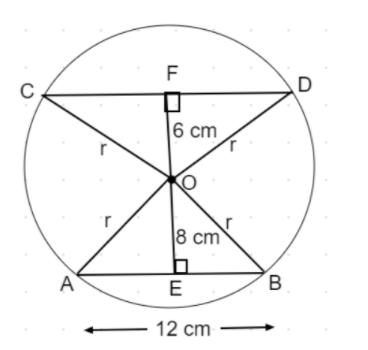
Answer
465.6k+ views
Hint: To solve this problem first we must measure the circle radius by applying the pythagoras theorem so for it we will assume the\[12{\text{ }}cm\] chord midpoint further after having the radius we will simply evaluate the necessary length of other chord by applying pythagoras theorem again.
Complete step-by-step answer:

Since a \[12{\text{ }}cm\] chord is \[8{\text{ }}cm\] away from the middle of the circle.
Suppose the center of the circle is O, and E is the midpoint of AB. Therefore both AEO and BEO are triangles with right angles.
So AE = Length of AB chord$/2$
and EO = \[8{\text{ }}cm\] ( given)
Let R be the radius of the circle
By applying pythagoras theorem in right angle triangle ∆ AEO we get
$\sqrt {{6^2} + {8^2}} = \sqrt {(36 + 64)} = \sqrt {100} = 10cm$
So the radius of circle is $10cm$
Now the chord CD is \[\;6cm\] from O.
Let us assume F is the midpoint of CD , so CFO and DFO both are right angled triangles.
FO = \[\;6cm\] ( given)
and CO=DO= $10cm$ ( radius of circle)
so CF=DF
By applying the pythagoras theorem in right angle triangle CFO we get
CF = \[ + \]$\sqrt {{{10}^2} - {6^2}} = \sqrt {(100 - 36)} = \sqrt {64} = 8cm$
Therefore the length of chord CD = CF \[ + \] DF = \[2{\text{ }} \times \]CF\[ = {\text{ }}2{\text{ }} \times {\text{ }}8{\text{ }} = {\text{ }}16{\text{ }}cm.\]
Hence the correct answer is option C.
Note: A circle chord is a part of a straight line whose endpoints both lie on the circle. A chord 's infinite line extension is a secant line, or literally secant line. More generally, a chord is a line segment that joins two points , for example an ellipse, at any curve.
Complete step-by-step answer:

Since a \[12{\text{ }}cm\] chord is \[8{\text{ }}cm\] away from the middle of the circle.
Suppose the center of the circle is O, and E is the midpoint of AB. Therefore both AEO and BEO are triangles with right angles.
So AE = Length of AB chord$/2$
and EO = \[8{\text{ }}cm\] ( given)
Let R be the radius of the circle
By applying pythagoras theorem in right angle triangle ∆ AEO we get
$\sqrt {{6^2} + {8^2}} = \sqrt {(36 + 64)} = \sqrt {100} = 10cm$
So the radius of circle is $10cm$
Now the chord CD is \[\;6cm\] from O.
Let us assume F is the midpoint of CD , so CFO and DFO both are right angled triangles.
FO = \[\;6cm\] ( given)
and CO=DO= $10cm$ ( radius of circle)
so CF=DF
By applying the pythagoras theorem in right angle triangle CFO we get
CF = \[ + \]$\sqrt {{{10}^2} - {6^2}} = \sqrt {(100 - 36)} = \sqrt {64} = 8cm$
Therefore the length of chord CD = CF \[ + \] DF = \[2{\text{ }} \times \]CF\[ = {\text{ }}2{\text{ }} \times {\text{ }}8{\text{ }} = {\text{ }}16{\text{ }}cm.\]
Hence the correct answer is option C.
Note: A circle chord is a part of a straight line whose endpoints both lie on the circle. A chord 's infinite line extension is a secant line, or literally secant line. More generally, a chord is a line segment that joins two points , for example an ellipse, at any curve.
Recently Updated Pages
Fill in the blanks with suitable prepositions Break class 10 english CBSE

Fill in the blanks with suitable articles Tribune is class 10 english CBSE

Rearrange the following words and phrases to form a class 10 english CBSE

Select the opposite of the given word Permit aGive class 10 english CBSE

Fill in the blank with the most appropriate option class 10 english CBSE

Some places have oneline notices Which option is a class 10 english CBSE

Trending doubts
Fill the blanks with the suitable prepositions 1 The class 9 english CBSE

How do you graph the function fx 4x class 9 maths CBSE

When was Karauli Praja Mandal established 11934 21936 class 10 social science CBSE

Which are the Top 10 Largest Countries of the World?

What is the definite integral of zero a constant b class 12 maths CBSE

Why is steel more elastic than rubber class 11 physics CBSE

Distinguish between the following Ferrous and nonferrous class 9 social science CBSE

The Equation xxx + 2 is Satisfied when x is Equal to Class 10 Maths

Differentiate between homogeneous and heterogeneous class 12 chemistry CBSE




